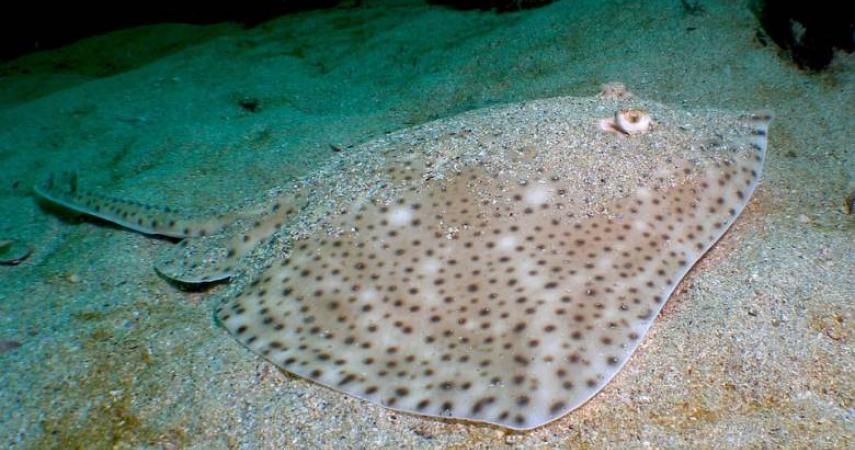The IIM leads the "CONECTEE" project in the Atlantic Islands of Galicia NP
It will evaluate and reinforce the work to conserve the diversity of coastal elasmobranchs carried out by the Parque Nacional das Illas Atlánticas de Galicia) in the Spanish Atlantic coastal strip using innovative methodologies such as acoustic telemetry or genomic techniques.
The research, directed by Alexandre Alonso Fernández, is financed by the Ministry for the Ecological Transition and the Demographic Challenge within the framework of the "Scientific research projects in the National Parks Network 2022" program.

Santiago de Compostela, Wednesday, January 27, 2023. The Higher Council for Scientific Research (CSIC) starts, with the leadership of the Mariñas Research Institute (IIM), the project "Ecological CONNECTIVITY and the role of the Atlantic Islands of Galicia National Park in the conservation of coastal Elasmobranchs (CONECTEE)”, with a duration of three years and financed by the Ministry for the Ecological Transition and the Demographic Challenge within the framework of the program “Scientific research projects in the National Parks Network 2022”.
The main researcher is Alexandre Alonso Fernández and the research team includes Francisco Saborido Rey, Sonia Rábade Uberos, Laura Casas Castaño and Gonzalo Mucientes Sandoval, from the Ecology and Marine Resources group. The project has the collaboration of the National Maritime Terrestrial Park of the Atlantic Islands of Galicia (PNMTIAG).
The main objective is to study the patterns of movement and behavior that determine the connectivity of subpopulations of coastal elasmobranchs in response to environmental pressures around the protected areas of the PNMTIAG. Acoustic telemetry will be used for this as the main methodology, a tool that will provide continuous estimates of movements at the individual level for long periods of time (months to years).
“Briefly, it consists of marking individuals with acoustic transmitters that will emit a signal every so often that will be stored in underwater receivers previously anchored in the study area. 100 individuals will be tagged over the course of the project. Genomic techniques will also be applied, which represents progress in the use of new approaches for the knowledge and monitoring of the open water ecosystems of the National Parks Network”, advances Alexandre Alonso Fernández.
Regarding the species selected as the object of study, the research team explains that "within the strategies for the conservation of marine biodiversity there are certain taxonomic groups that are especially vulnerable due to their vital history and their role in the ecosystem. This is the case of elasmobranchs: sharks and rays”.
“To achieve the main objective of the research, it is necessary to obtain adequate knowledge of the ecological connectivity of coastal elasmobranchs. This will make it possible to make proposals for the designation of new protected areas or for the expansion or adaptation of existing ones in the face of future scenarios, including climate change”, highlights Alexandre Alonso Fernández.
Within this great global objective we identify the following specific objectives such as identifying the population connectivity of the species of coastal elasmobranchs that inhabit the environment of protected marine spaces in Galician Atlantic waters; to estimate the degree of genetic connectivity of the coastal elasmobranch species that inhabit the environment of protected marine spaces in Galician Atlantic waters; evaluate the effectiveness of existing spatial protection measures based on the scientific evidence obtained; identify evidence-based conservation needs to propose new or modify existing protected areas and maintain and strengthen spatial connectivity and increase social commitment to the protection and conservation of our marine biodiversity, especially coastal elasmobranchs.
The CONECTEE project represents the consolidation of the line of research on spatial ecology and conservation initiated in previous projects by the research group, such as the TAC project (2018, Biodiversity Foundation), which allowed the implementation of a monitoring network of the behavior and movements of marine organisms that gave rise to the first scientific publications on the spatial ecology of marine elasmobranchs in the area; or the iGENTAC project (2020, Fundación Biodiversidad), with which they developed tools based on minimally invasive sampling techniques for the implementation of coastal species monitoring programs in a protected marine area.
“CONECTEE is a step forward in relation to the advances made in previous projects. Specifically, we will apply a novel approach combining monitoring of individuals at multiple spatial scales that will allow us to monitor highly mobile species, such as coastal elasmobranchs, over long periods of time. We will also use a multidisciplinary approach to the study of connectivity”, the research team emphasizes.
The data obtained from the research will be incorporated into the ETN (European Tracking Network), a pan-European initiative to integrate all the acoustic monitoring networks in operation.
